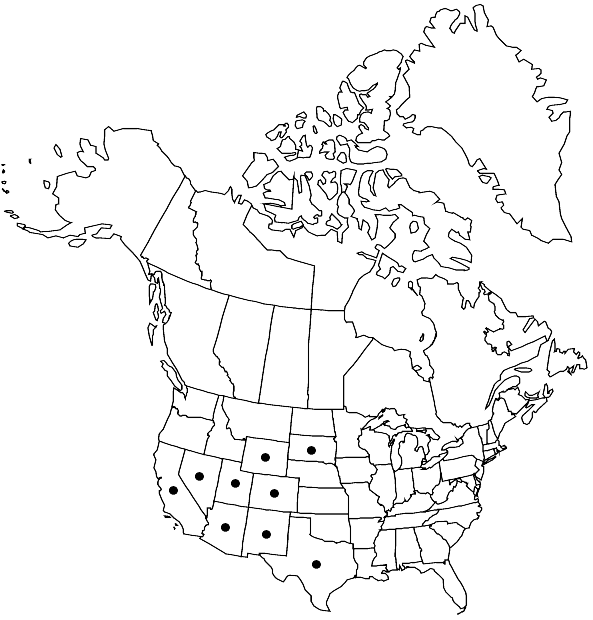Difference between revisions of "Tortula inermis"
Arch. Bot. (Leipzig) 1: 136. 1832,.
FNA>Volume Importer |
FNA>Volume Importer |
||
| Line 28: | Line 28: | ||
|elevation=low to high elevations (0-2000 m) | |elevation=low to high elevations (0-2000 m) | ||
|distribution=Ariz.;Calif.;Colo.;Nev.;N.Mex.;S.Dak.;Tex.;Utah;Wyo.;Mexico (Baja California;Chihuahua;Sonora);Europe;s Asia;n Africa. | |distribution=Ariz.;Calif.;Colo.;Nev.;N.Mex.;S.Dak.;Tex.;Utah;Wyo.;Mexico (Baja California;Chihuahua;Sonora);Europe;s Asia;n Africa. | ||
| − | |discussion=<p>Tortula inermis has the aspect of a Syntrichia with its ligulate, apiculate leaves and strong costa, but the plant is yellow or orange in KOH solution, and the costal section reveals a rounded stereid band. It is related to T. subulata and T. mucronifolia but the lack of a strong mucro and the narrow but nearly complete recurving of the leaf margins are diagnostic.</p> | + | |discussion=<p><i>Tortula inermis</i> has the aspect of a <i>Syntrichia</i> with its ligulate, apiculate leaves and strong costa, but the plant is yellow or orange in KOH solution, and the costal section reveals a rounded stereid band. It is related to <i>T. subulata</i> and <i>T. mucronifolia</i> but the lack of a strong mucro and the narrow but nearly complete recurving of the leaf margins are diagnostic.</p> |
|tables= | |tables= | ||
|references= | |references= | ||
| Line 52: | Line 52: | ||
|publication year= | |publication year= | ||
|special status= | |special status= | ||
| − | |source xml=https://jpend@bitbucket.org/aafc-mbb/fna-data-curation.git/src/ | + | |source xml=https://jpend@bitbucket.org/aafc-mbb/fna-data-curation.git/src/8f726806613d60c220dc4493de13607dd3150896/coarse_grained_fna_xml/V27/V27_861.xml |
|subfamily=Pottiaceae subfam. Pottioideae | |subfamily=Pottiaceae subfam. Pottioideae | ||
|genus=Tortula | |genus=Tortula | ||
Revision as of 17:58, 18 September 2019
Leaves lingulate, apex rounded-acute, apiculate to short-mucronate, margins recurved from base to near the apex, not bordered; costa subpercurrent, percurrent or very short-excurrent, lacking an adaxial pad of cells but distally narrowing or weakly thickened, 3–4(–5) cells across the convex adaxial surface; distal laminal cells hexagonal, (12–)15–18 µm wide, 1:1, strongly papillose with 4–5 2-fid papillae. Sexual condition gonioautoicous. Sporophytes exerted. Seta 1.2–1.5(–2.5) cm. Capsule stegocarpic, not systylius, cylindric, erect and nearly straight, urn usually 3–4 mm; peristome length 1000–1500 µm, teeth of 32 filaments twisted at least one full turn, basal membrane 300–600 µm; operculum 1.3–1.6(–2) mm. Spores 11–15 µm, spheric, finely papillose.
Phenology: Capsules mature spring.
Habitat: Soil, rock
Elevation: low to high elevations (0-2000 m)
Distribution

Ariz., Calif., Colo., Nev., N.Mex., S.Dak., Tex., Utah, Wyo., Mexico (Baja California, Chihuahua, Sonora), Europe, s Asia, n Africa.
Discussion
Tortula inermis has the aspect of a Syntrichia with its ligulate, apiculate leaves and strong costa, but the plant is yellow or orange in KOH solution, and the costal section reveals a rounded stereid band. It is related to T. subulata and T. mucronifolia but the lack of a strong mucro and the narrow but nearly complete recurving of the leaf margins are diagnostic.
Selected References
None.